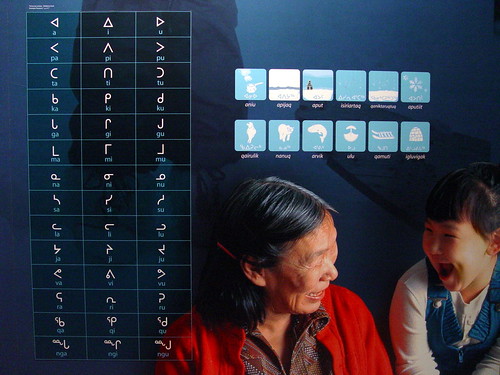Assorted thoughts and reflections on technology in education, and other things ...
Wednesday, December 16, 2015
MOOCs - the price of recognition
The freemium model (try out for free but then you have to pay) for MOOCs is gaining ground rapidly and price tags are appearing on everything except basic access to the material. Until now you could get a free certificate on completion of a MOOC but not anymore according to an article in Class Central, MOOC Trends in 2015: The Death of Free Certificates. Udacity, Coursera and FutureLearn all charge for even the basic course completion certificate and now EdX have announced that they will follow suit. Of course the free certificates did not really translate into credential hard currency but were a nice recognition of course completion. Now it seems the major MOOC consortia see even the most basic certificates as a source of income, indicating that investors are looking for higher returns after the initial free education for all rhetoric has died down. It can also be an attempt to answer the criticism that certificates for simple course completion were not worth the pixels they were written on, given that there are no guarantees that the person receiving the certificate actually did the work. Does the payment of a fee raise the value of the credential? If I have to pay for something that was previously free there should be added value.
It seems that we have reached an interesting point in the MOOC saga. The open and free part is shrinking and without completion certificates the plain vanilla MOOC becomes a collection of not-so-open educational resources that you are welcome to use for your own development but without any kind of recognition. Mainstream MOOCs are now officially commercial operations but you can access the material if you want. There's certainly nothing new here since many universities have shared their resources as open courseware for many years (MIT OCW, OpenLearn etc) and you are free to access the material whenever you want. The MOOCs provide a structure for you to follow but if you need recognition you will have to pay. In some cases the price of recognition is increasing with certificates (of varying levels of dignity) ranging between $25 - $300 per course. It's still cheaper than the for-credit options but then again the credits are valuable hard currency compared to MOOC certificates.
Paying customers are more likely to complete the course and as we move to a more layered model for MOOCs we will see completion rates based only on the numbers of paying participants whilst the free learners merely demonstrate the level of general interest. As I have written before I think it really is time to stop using the term MOOC and find more realistic descriptions. On the one hand we have a largely commercial field offering massive online courses for fees with a variety of certificates and even credits. On the other hand we have the field of genuinely open courses run as collaborative projects or as part of a community. These are open in terms of access as well as offering material for reuse and adaptation. They may not be as glossy and polished as the commercial courses but they are non-profit and run on enthusiasm and pioneer spirit. Both options serve a purpose and will continue to evolve but let's stop confusing the two and pushing them both into the uncomfortable box labelled MOOC.
Sunday, December 13, 2015
The challenge of self-directed learning
We learn all through our lives almost unconsciously by watching, reading, listening, testing, failing and persevering. In fact most people don't realize the value of informal learning since it takes place as a natural part of everyday life. We have a natural ability to acquire new skills and the process is mostly social, learning from others, getting advice, copying and adapting. This takes place without anyone planning or leading the activity. However when we want to acquire more advanced skills we turn to formal education which is planned and lead by skilled professionals, teachers. Some people are able to acquire even advanced skills informally as self-directed learners but most of us are dependent on teachers to lead us through the process. The role of the teacher is so crucial that it can either inspire us or make us avoid the subject for the rest of our lives. This teacher dependence is possibly both the strongest and weakest factor in formal education.
When we scale education, either in large campus cohorts of 200 plus students in a large lecture hall or in a MOOC on the net, we tend to emphasize the role of the charismatic teacher, leading the course from the stage (physical or digital) but lose the the benefits of close contact and guidance that works so well in small groups . I've written many times about the problem facing MOOCs, and indeed large campus clases; how to scale interaction and the beneficial influence of good teaching. When you have one or a few teachers leading a massive course the link between them and the learners becomes weak and learners must fend for themselves. Learners either have to develop strategies for effective self-study or take the initiative to establish a study group for mutual support. These are skills that few have since we are so dependent on learning being organised for us.
Most MOOCs are run like formal courses with fixed start and finish dates and a linear progression through a pre-set package of content. This fixed structure provides a clear framework, opportunities for interaction (at least between peers), a sense of participation and the deadlines that many people need to keep on track. However, the downside is that many drop out when other priorities disrupt the tight course schedule. An alternative approach that is growing in popularity is that of self-paced MOOCs where you are free to study at your own pace and you can start the course whenever you want. Here the advantages of flexibility and convenience are offset by the challenges of self-study and lack of support. Self-paced MOOCs are discussed in an article on Class Central, MOOC Trends in 2015: Rise of Self Paced Courses.
Self paced courses are a clear boon to those students who want scheduling flexibility, but they also remove key elements that have been part of the “MOOC” formula that has been so popular. Such elements include the benefits of tens of thousands (if not hundreds of thousands) students taking the course together and learning at the same pace. According to Class Central user Greg Hamel, who has completed more than one hundred MOOCs: “Lack of schedule means students are not all learning the same material at the same time. This makes it harder to get help and discuss course content.
However regardless of the model, massive courses suffer from a low sense of belonging and are therefore best suited to self-directed learners, a rare commodity outside academic circles. A self-paced MOOC sounds attractive but without deadlines only experienced self-directed learners will complete them. As more and more education becomes "on demand" the need to explicitly teach self-directed learning will increase. Until then the vast majority still need the guidance and supervision that a teacher-lead course offers and the question in how to offer this in a massive online course.
One solution to this is to offer learners local or regional teacher-supported groups to complement the MOOC, as described in a new article in the journal IRRODL (Nov 2015), Using MOOCs at Learning Centers in Northern Sweden, Here in Sweden there is a network of municipal learning centres that provide support for distance learning as well as hosting distributed courses. This article describes an attempt to offer local support for a global MOOC where local participants in the MOOC could meet regularly and discuss the course topics in Swedish with support and a university teacher who examined them at the end of the course so they could get a university certificate as well as the MOOC-provider's certificate. This hybrid solution could benefit both learners and universities. By having access to a small local study group and support the learners are more likely to complete the course and gain the additional benefit of getting a certificate that has more local recognition than the one provided by the MOOC provider. An increase in course completion will also benefit the provider. MOOCs should welcome third party add-on services like this. It can be a lifeline for all those who are not self-directed learners.
Tuesday, December 1, 2015
Reading around the world
I can recommend that you watch this TED talk by Ann Morgan (below), My year reading a book from every country in the world. She decided to read a book from every country in the world and here she describes how she succeeded. It was not an easy task since only a fraction of the world's published fiction ever gets translated to English whilst the best-selling titles in English tend to be translated to almost every other language. She considered herself very well read but realised that her perspective was of course almost exclusively that of the English speaking countries, in particular the UK and the USA. Her challenge was a daunting one since many countries had little or no accessible literature for speakers of English or other major western languages. She succeeded thanks to networking, spreading the word on social media and benefitting from some remarkable crowd-sourcing when stories were translated into English but volunteer enthusiasts.
This is a heart-warming success story and a tribute to the collaborative and open culture on the net that so seldom gets media coverage. It also highlights the potential of crowd-sourced translation to bring literature from developing countries to a global audience. Very few, if any, commercial publishers will risk commissioning English translations of works from, say, Burkino Faso, Kazakhstan or Laos but groups of students, teachers or writers could share the task and produce open e-books, not for commercial gain but as showcase for the country's writers. It's a similar model to sites like Jamendo that offer free music with Creative Commons licenses that can be downloaded and reused. The musicians make no money from this but can gain global reputation and recognition that may result in commercial opportunities later on. Time for an open literature movement to promote world literature?
Another difficulty in reading around the world is that the vast majority of world languages are not even on the net yet according to an article in The Atlantic, The Internet Isn't Available in Most Languages.
This is a heart-warming success story and a tribute to the collaborative and open culture on the net that so seldom gets media coverage. It also highlights the potential of crowd-sourced translation to bring literature from developing countries to a global audience. Very few, if any, commercial publishers will risk commissioning English translations of works from, say, Burkino Faso, Kazakhstan or Laos but groups of students, teachers or writers could share the task and produce open e-books, not for commercial gain but as showcase for the country's writers. It's a similar model to sites like Jamendo that offer free music with Creative Commons licenses that can be downloaded and reused. The musicians make no money from this but can gain global reputation and recognition that may result in commercial opportunities later on. Time for an open literature movement to promote world literature?
Another difficulty in reading around the world is that the vast majority of world languages are not even on the net yet according to an article in The Atlantic, The Internet Isn't Available in Most Languages.
At the moment, the Internet only has webpages in about five percent of the world's languages. Even national languages like Hindi and Swahili are used on only .01 percent of the 10 million most popular websites. The majority of the world’s languages lack an online presence that is actually useful.
So even if the infrastructure and technology are available there is simply very little to read there for millions of people. The popular social media lack instructions and templates in most languages making them impossible to use. We need to find innovative strategies to widen the linguistic range of the internet and ensure that there is relevant content for all. The notion that open educational resources, MOOCs and so on can make education accessible for all will not happen until those resources are available in many more languages than today. The lack of linguistic diversity on the net deserves more attention and we need to find ways to stimulate the development of digital content in all languages. A lot can be done by volunteer grassroots initiatives, providing free open platforms, training and support, but more stimulus, especially financial, is required from national and international organisations.
So even if the infrastructure and technology are available there is simply very little to read there for millions of people. The popular social media lack instructions and templates in most languages making them impossible to use. We need to find innovative strategies to widen the linguistic range of the internet and ensure that there is relevant content for all. The notion that open educational resources, MOOCs and so on can make education accessible for all will not happen until those resources are available in many more languages than today. The lack of linguistic diversity on the net deserves more attention and we need to find ways to stimulate the development of digital content in all languages. A lot can be done by volunteer grassroots initiatives, providing free open platforms, training and support, but more stimulus, especially financial, is required from national and international organisations.
Wednesday, November 25, 2015
Is the customer always right?
Education at all levels is awash with evaluation forms and needs analysis surveys. We all want feedback but are we asking the right questions? Development projects are based on needs analysis, assuming that we should only develop services that customers/staff/students really require. The problem with this approach is that you don't need what you don't know. If we only designed products and services that people needed we would never have had cars, television, computers, mobiles or the internet. No-one needed them until they had been developed. So asking for needs can help but is often not the right approach for innovation. The same applies to student satisfaction. We assume that if students are satisfied with a course then the teacher has done a good job and the students have learnt a lot. Or have they?
Education, unlike products and services, cannot be judged on simple customer satisfaction. Students are satisfied if they get a good grade but that doesn't always mean that they have learnt very much or that the course was well designed. An article on The Conversation, Students don’t know what’s best for their own learning, highlights the problems of judging education by satisfaction. Students tend to give good evaluations to teachers who don't demand too much, are entertaining and give them good grades. Those who make them work hard and don't serve all the answers on a plate are generally less popular. Teachers who try innovative new methods that force students to take charge of their learning and really grapple with working out concepts for themselves often face negative evaluations and possibly a resultant stern talk from their head of department. Many students (and teachers) mistake content for learning.
That is why many students assume that reading or highlighting passages in their text-book, or merely listening to a lecture, is enough to produce learning. They mistake the ease of the task with greater knowledge. Time-consuming and effortful tasks, like self-testing their knowledge, are consequently seen by students as less efficient for their learning, despite the fact that the more difficult tasks produce the most learning.
Of course it is good to find out what students thought of a course but we need to steer away from simply measuring satisfaction and provide them with a new set of rubrics that allow them to gauge their effort, collaboration, acquisition of new skills and how they have met new challenges. This type of evaluation takes time to learn but that way we will get more reliable criteria for assessing course quality. At the end of a good course you may feel rather tired, maybe irritated and sore but you also realise that you've achieved something. We need to learn to appreciate teaching that challenges us and pushes us forward even if it hurts a bit.
Education, unlike products and services, cannot be judged on simple customer satisfaction. Students are satisfied if they get a good grade but that doesn't always mean that they have learnt very much or that the course was well designed. An article on The Conversation, Students don’t know what’s best for their own learning, highlights the problems of judging education by satisfaction. Students tend to give good evaluations to teachers who don't demand too much, are entertaining and give them good grades. Those who make them work hard and don't serve all the answers on a plate are generally less popular. Teachers who try innovative new methods that force students to take charge of their learning and really grapple with working out concepts for themselves often face negative evaluations and possibly a resultant stern talk from their head of department. Many students (and teachers) mistake content for learning.
That is why many students assume that reading or highlighting passages in their text-book, or merely listening to a lecture, is enough to produce learning. They mistake the ease of the task with greater knowledge. Time-consuming and effortful tasks, like self-testing their knowledge, are consequently seen by students as less efficient for their learning, despite the fact that the more difficult tasks produce the most learning.
Student evaluations can therefore be dangerously misleading and result in "easy" courses being encouraged and more demanding courses modified to please the customers. Lectures are still popular because they provide the "answers" in one easily digestible session and many still equate lecturing with teaching. As a result students will generally give positive evaluations to teachers who give them what they expected. Seeing this as a measure of course quality can have serious consequences according to the article.
... universities that rely on student evaluations are likely to punish good teachers and encourage those who simply make it easy for students. Most universities have codes of conduct that require decisions to be made on valid evidence. Any manager discussing student evaluations when reviewing lecturers’ performance is probably breaching that part of their own job requirements. Given the evidence, student evaluations are a distraction from the responsibility to provide the best possible education for the nation.Of course it is good to find out what students thought of a course but we need to steer away from simply measuring satisfaction and provide them with a new set of rubrics that allow them to gauge their effort, collaboration, acquisition of new skills and how they have met new challenges. This type of evaluation takes time to learn but that way we will get more reliable criteria for assessing course quality. At the end of a good course you may feel rather tired, maybe irritated and sore but you also realise that you've achieved something. We need to learn to appreciate teaching that challenges us and pushes us forward even if it hurts a bit.
Friday, November 20, 2015
Recorded lectures - what's the point?
A college of mine raised an interesting question. Why do we automatically record so many lectures and meetings that no-one ever watches? Just because we can easily record and store events doesn't mean that we have to. The problem is that many universities are now recording all their lectures without really pausing to think why they are doing so. Many are watched by a very small number of people, often only for a few minutes per person, and some are never watched at all. Should we maybe think more carefully about what we record and how long it should be available?
It's part of our passionate and rather tragic love affair with lecturing - breaking up is indeed very hard to do. It's is the backbone of most university teaching; it's easy to do, it's very scalable and it feels like teaching. Lecture capture systems are extremely popular, probably because we can continue lecturing as usual but feel modern because they're all available online as well. Nothing has changed, just a nod in the direction of some kind of modernity. Then there's the flipped classroom approach which in its simplest interpretation means pre-recording the lecture and letting students view it as preparation for discussion or workshops in class. That at least avoids gathering students to simply listen to one-way communication but the point here is if you are going to flip the class, why is the lecture the option of choice? I'm certainly guilty of recording quite a few sessions like this and admit that viewing figures are far from viral. Do we really learn so much from lectures and could we use that time more fruitfully?
I don't mean that the lecture should be completely abandoned. A really polished and well delivered lecture can certainly inspire and provoke discussion and reflection but maybe it should be used sparingly, as an event that cannot be missed. Instead we could focus more on shorter inputs on the lines of a TED talk, offering insights but also asking questions that the students should find out for themselves. Critics will warn that such an approach risks simplifying everything into convenient and easily digested "sound-bites". But the point here is to replace the lecture with something else, not a just a shorter version. Instead we should record a short introduction to the subject that raises questions and issues for the students to investigate and process. Start a discussion, provoke deeper thought, inspire investigation, instead of providing all the answers. The lecture represents a spoon-feeding approach that is certainly appreciated by students who want to be fed but as long as we continue to lecture, face-to-face or online, it is hard to move towards student-oriented learning.
So before you decide to press that record button stop and think about the value of your lecture. Do I need to demonstrate how much I know or do I want to encourage the students to investigate for themselves, search for information, compare sources, analyse results and present their findings? The answer is clear but I have a feeling it's going to be a difficult detox process.
Sunday, November 15, 2015
MOOCs as open ecosystems
I'm still waiting for the day we can assign the term MOOC to the acronym graveyard (let's discuss open education instead of a cryptic four letter term that is far too vague and open to many interpretations). In the meantime the courses keep coming and the debate continues. The public image of MOOCs is that of the high-end expensive and highly polished courses coming from the major players (Coursera, EdX, FutureLearn etc) and the public perception is that of recorded lectures, self-study and automated self-testing. Little attention is given to all the open, collaborative learning that takes place under the radar without the use of expensive platforms, franchising and tall budgets. So often MOOCs and online education are seen as synonyms rather than the former being a small but highly visible subset of the latter. One recent article by three Stanford professors in Inside Higher Ed, What We’ve Learned From MOOCs, draws conclusions from that university's MOOC ventures in recent years. The article contains few surprises but it's worth discussing some of the points they make.
MOOCs in their present form are not the answer to wider access to higher education.
So far they have mostly attracted professionals in developed countries and have not reached those who have no access to traditional higher education. The issue here is providing better support to new student groups, for example by allowing local institutions to provide technical support and help with study skills in the local language, Universities can't provide all the support that inexperienced online learners need and so they need to offer an open interface so that local support structures can easily be added to the ecosystem. Remember that the vast majority of the world has never heard of MOOCs and are often not even aware of online education. They won't find a MOOC unless someone (a local school, community centre, library) tells them about it. Their participation and success will very much depend on the local support they receive and no amount of video guides, FAQ pages or user forums from a far-off university can really replace this. Let's try this approach more and see if the accesibility vision for MOOCs can be realised. We have only just started to address this issue.
This is really a no-brainer since the over-reliance on lecturing are exactly what's wrong with traditional higher education. The problem both on campus and online is that universities focus on lecturing not because it enhances learning but because it's easy and cheap to do. Lecturing is very scalable whereas tutoring and interaction are not. This is not just a problem for online courses, many campus students have very little interaction with their teachers. However there are many online courses today that are built around collaboration and interaction and many MOOCs today are experimenting with methods to increase engagement.
MOOCs have raised awareness of the potential on online learning
This is certainly true since so many elite universities have suddenly discovered the field after many years of denial. Martin Weller points out in a short but insightful post, Lessons from the MOOC investment gold rush, that the motivation for many top universities entering the MOOC fray was the fear of been seen as out of date. MOOCs certainly put online learning in the media spotlight and consequently on the boardroom agenda. The problem however was that the MOOC boom failed to build on the lessons learned from years of successful online education at thousands of universities worldwide. The pointlessness of simply stacking up recorded lectures, pdf-files and PowerPoints on a web site and the importance of creating learning communities and fostering peer engagement were well-known before mainstream MOOCs came along (especially in the early collaborative MOOCs of Siemens, Downes, Cormier, Alexander etc). Maybe now the strands can be linked.
MOOCs certainly haven't fixed anything but they have widened the discussion that was previously restricted to the pioneers and enthusiasts. MOOCs are one element in an ongoing process of experimentation and innovation as education comes to terms with digitalisation and since this is work in progress it's wrong to dismiss the conecpt as failed. It hasn't really started yet. However, one thread running through my comments above is the need to stop seeing MOOCs as the product of one institution or one platform. If you offer a MOOC and you really want diversity, accessibility and higher levels of learner engagement you need to open up the concept and let other institutions and initiatives add auxiliary services, provide local support, adapt to local language and culture and offer alternative forms of engagement. That way I think there is a future for MOOCs. Let's just change the name please.
Thursday, November 5, 2015
Online IS "in real life"
We seem to have a love-hate attitude to digital technology. On the one hand we're buying and intensively using all the shiny devices we can get our hands on but at the same time we seem to be terrified of them. Mobiles and tablets are often portrayed as dangerous obsessions that are killing human interaction and turning us into zombies. We all enjoy jokes about people gazing into their mobiles, oblivious of the world around them, and long for the good old days when people spoke to each other. It's easy to criticize but maybe we should consider what people are actually doing when they're looking at their screens.
An excellent article by Héctor L. Carral, Stop saying technology is causing social isolation, is the perfect myth-buster. When we see everyone on a train staring into their screens many people feel provoked, claiming that mobiles are enslaving us. Why don't we talk to each other anymore? But if we cast our minds back 30 years or so I don't remember any spontaneous discussions with fellow commuters then either. We all buried out heads in the morning paper or a book - what's the difference? I used to get really bored standing at cold windy stations or bus stops with nothing to do but gaze into space. Today I use that time to listen to wonderful music or podcasts, see how my friends are doing, admire photos from friends, take part in a discussion or check my e-mails. We probably communicate more than ever before thanks to digital technology.
My main premise is that I don’t think smartphones are isolating us, destroying our social lives or ruining interactions. I see smartphones as instruments for communication. Instruments that enable interaction on ways that just weren’t possible before, connecting us with people all around the world, via Twitter, instant messaging or other services. Some may say that if you want to interact with people, you should interact with the ones around you, and that is probably true on certain occasions. But, on other occasions, I’m just not able to comprehend why should we be forced to interact with those physically close to us instead of with the people that we really want to interact with.
One reason for this suspicion of technology is the fact that many still only use it for entertainment and passing the time. We worry that we are becoming passive consumers of trivial entertainment rather than acknowledge the active, communicative and creative opportunities of digital technology. There's also the idea that communicating with friends digitally is not "real" communication and becomes the opposite of "in real life". Somehow your online contacts are labelled as virtual or in some way "unreal". In the past people discussed anonymously in chat rooms using pseudonyms and with cartoon characters as avatars. Here you had no idea who you were actually talking to and it was understandable that this was not seen as real communication. However today we mostly communicate with people we know and use real photos and profiles of ourselves to establish trust. When identities are clear and trust is established online communication is definitely "in real life" and I can have just as intensive face-to-face discussions with online colleagues using tools like Skype as I can have if we were in the same room. I see their faces, eye movements and body language.
As digital literacies are developed so will our perceptions of online behaviour. When we make the leap from being consumers to being producers and collaborators we will hopefully lose these negative stereotypes that are still so prevalent today. It's time to drop expressions like IRL, cyberspace, virtual and everything beginning with e- and realise that it's all about real human communication, but using the opportunities offered by new media.
As digital literacies are developed so will our perceptions of online behaviour. When we make the leap from being consumers to being producers and collaborators we will hopefully lose these negative stereotypes that are still so prevalent today. It's time to drop expressions like IRL, cyberspace, virtual and everything beginning with e- and realise that it's all about real human communication, but using the opportunities offered by new media.
Friday, October 30, 2015
Fine tuning
I've written many times about the issue of silent learners, also known as peripheral or even drive-by learners. In all forms of education there are learners who stay in the background and remain almost invisible throughout the course. This can be due to a lack of confidence or even lack of interest but is often because the learner simply prefers to listen, observe and then reflect alone. Some people simply don't want to take part in group work or perform in front of peers. Should we try to encourage them to participate more or should we give them space to learn on their own? In the classroom this can be more easily tackled by having a chat but in an online setting, especially in a MOOC, these learners simply disappear.
I've just started a project with some colleagues from the Nordic region to investigate whether silent learners are simply "lurking" or whether they are really learning and whether we should design courses to offer space for a more silent and solo learning path (see project description). Are silent learners more or less likely to complete a course? I believe that many learners adapt their learning strategies according to the situation and that the same person can be a highly active collaborative learner in one course and then a silent learner on the next. It depends often on a conscious decision on how much you want or need to engage.
This idea was reinforced by a blog post by Simon Broek on the European adult learning portal EPALE, Thoughts on the concept of learning. Your level of engagement depends on why you take the course. If you see the course as the key to a new career you will engage wholeheartedly whereas if it is simply "good to know something about" then you will not be prepared to invest so much energy. Learning can have different intensities and purposes and the two are interrelated.
I would like to start thinking about the concept of learning by looking at different purposes and intensities of learning.
- Learning is a broad concept having different intensities, such as adding bits of new knowledge to your body of knowledge and overthrowing everything you once understood as being true.
- In addition, learning can have different purposes; for instance being able to answer a question, to carry out a task, or using your knowledge and understanding to develop new knowledge and start innovations.
Learning depends a large number of variable factors and all can be fine-tuned according to the situation.We all move up and down these scales even during the same course with certain periods when we are deeply involved and collaborative followed by quieter more passive periods. One week's task can inspire me to work really hard but the following week's task or material is less inspiring. One week I've got other pressures that dominate and my attention to the course suffers as a result. Maybe I joined the course without any clear reason and once it got going I felt I should tag along but with the minimum effort; maybe I'll learn something from it.
How can we help to raise learners' commitment levels without too much simple carrot and stick? An article in Edutopia, Strategies to Build Intrinsic Motivation, suggests several methods to encourage learners to set their own goals and level of commitment. Asking learners to rate how likely they are to complete the course, getting them to write public goals about their commitment to the course or the week's topic, drawing up a learning contract and getting the group to write class rules can all be ways of raising intrinsic motivation rather than relying on the rewards and rules that the teacher traditionally imposes.
In the end however I think we have to accept that learning depends on so many variables and we all adjust these constantly just like a sound studio technician. We will seldom get the mix perfect but we can at least try to create the right prerequisites.
How can we help to raise learners' commitment levels without too much simple carrot and stick? An article in Edutopia, Strategies to Build Intrinsic Motivation, suggests several methods to encourage learners to set their own goals and level of commitment. Asking learners to rate how likely they are to complete the course, getting them to write public goals about their commitment to the course or the week's topic, drawing up a learning contract and getting the group to write class rules can all be ways of raising intrinsic motivation rather than relying on the rewards and rules that the teacher traditionally imposes.
In the end however I think we have to accept that learning depends on so many variables and we all adjust these constantly just like a sound studio technician. We will seldom get the mix perfect but we can at least try to create the right prerequisites.
Sunday, October 25, 2015
The invisible campus - part-time online students
If you look at most university websites you get the clear impression that their target group is between the ages of 18 and 23. That of course is the traditional target group but is far from reality at many institutions as the demand for higher education among the population over 23 grows rapidly. Many universities have been working with extension programmes and professional development for many years but still there are seldom photos of older students studying at home or in the workplace. Somehow the traditional university profile is the preferred one and the one most institutions identify most closely with. The younger students are of course the ones who fill the campus and use the often expensive and impressive buildings and classrooms. Furthermore they commit themselves to at least three years of full-time on campus studies which also forms the basis of the university's funding. Basically campus degree programmes and research are what the institutions are designed for. Everything else is an optional extra (though I'm fully aware there are glowing exceptions, but all too few).
Despite an increasing worldwide demand for more part-time online courses those are the ones being cut as governments and institutions economize and the result in many countries is that institutions are focusing on the supposed core business of campus degrees. An article in The Conversation called Part-time students feel squeezed out by universities obsessed with teenagers, spotlights the situation in England where the number of part-time students almost halved between 2010 and 2014. One reason for this is the sharp increase in fees that have been particularly steep for the part-time segment but the trend is also evident in many other countries such as here in Sweden. A recent report (in Swedish) by the Swedish Confederation of Professional Employees showed a significant downturn in part-time courses for professional development and called for a change in government policy. It feels like this potentially major sector for higher education is simply not being prioritised.
The problem is that there is often no clear strategy for this form of higher education and it is provided to the extent each institution feels is justified. It is an optional extra that doesn't make any impact on rankings or funding and therefore is always vulnerable when funding is low. This category of students is radically different to traditional students: studying part-time but often combining studies with full-time work, family and other commitments with no option of moving to a university campus. They generally don't identify themselves as students at all and have seldom any connection to student organisations. This in turn means that their views are not voiced when elected student representatives meet with faculty and administration. This means that part-time students are largely invisible and according the the article in The Conversation they feel increasingly marginalised.
This is an extremely important sector for higher education that deserves more attention. These students need short, flexible courses, mostly online, to enhance their career opportunities or enable them to apply for new jobs or change career. This market is more interested in sub-degree credentials rather than full-blown 3-4 year degrees and there is a growing interest in varieties of competence-based degrees, nano-degrees, badges and other forms of recognition.
Part-time higher education has a crucial role to play in social mobility. Opportunities to study part-time are at the forefront of widening access to the most disadvantaged adults, those vulnerable non-traditional students attempting a tentative first step into higher education. Part-time study has a positive affect on the economy, with mature students (the vast majority of whom are in full-time employment) seeking better careers in a global economy.
This niche has enormous potential but sadly there are few incentives for universities to focus on it. National strategies and funding are needed as well as ways of recognising and rewarding institutions that succeed. We need more institutions who see part-time, online study as their core business rather than a little sideline.
If the part-time sector is not to be inadvertently left to wither away, politicians need to create incentives for universities and colleges to prioritise part-time higher education as an attractive choice to meet the needs of the most disadvantaged students.
The alternative is that if higher education cannot meet the demand then someone else will.
Wednesday, October 14, 2015
Conferences as personal development
I go to quite a lot of conferences, project meetings and other academic gatherings and feel privileged to be able to do so. I meet so many talented people and get lots of ideas for my own work. Very often the seeds of new projects and cooperation are sown at these gatherings. I often put a lot of time and effort into writing reports and blog posts about the events I attend and hope others will be suitably inspired (my last post on this blog is a perfect example). However I have also realised that colleagues at home are seldom as interested in my discoveries as I used to expect - they have other things on their minds quite simply.
An article by Karen Dillon in the Harvard Business Review, It’s OK If Going to a Conference Doesn’t Feel Like Real Work, had me nodding in recognition all the way through. She used to feel obliged to make copious notes at conferences and write lengthy reports full of useful links for her colleagues in order to prove that she had been working hard while away from the office. There's a certain feeling of guilt involved in not being at your desk or in the classroom that requires you to over-compensate. However, noting that her colleagues were not exactly captivated by all her reports and tips, she realised that she had to change her perspective.
Once I gave up being the “super attender,” I started to engage with fellow attendees completely differently. I remember them, personally, and their areas of enthusiasm. For years now, I’ve been able to connect people—helping colleagues or peers find just the right person to talk to because I remembered meeting someone at a conference, absorbed their perspective in the moment, and kept it in mind (rather than recording their credentials in a report).
Basically the benefits of participating in events are mostly personal, widening your network, making connections, gaining understanding and getting new ideas. As a manager Dillon has adopted a policy of letting her staff go to conferences and enjoy the experience rather than feel they have to pay for it through reporting back. The pay-off for the organisation may come later when you are able to put a colleague in touch with someone you met at a conference or are able to use your network to solve a local problem. The benefit to your institution is that you get a chance to grow. You shouldn't need to prove that it was worth the time.
This seems to be part of a bigger issue. We are still rather constrained by feelings that we only really work when we're in our workplace and that any time away from there is an easy option. It seems we are in a rather long period of transition between traditional models of working/teaching/learning and new models. From office hours and desk time to flexible working, from teaching content to facilitating learning, from testing memory to solving problems. Many organisations and people are caught between these models and both can confusingly apply in the same organisation, often in the tension between the organisation's vision and reality. In theory we support flexibility but there's still the deep-seated belief in traditional values. Teachers can try innovation but risk getting bad evaluations from students who expect the teacher to "teach" i.e. lecture. So when we go to a conference or anything that's away from the office we still feel we need to compensate for not "being at work". Old habits die hard and this transition period is likely to continue for some time.
This seems to be part of a bigger issue. We are still rather constrained by feelings that we only really work when we're in our workplace and that any time away from there is an easy option. It seems we are in a rather long period of transition between traditional models of working/teaching/learning and new models. From office hours and desk time to flexible working, from teaching content to facilitating learning, from testing memory to solving problems. Many organisations and people are caught between these models and both can confusingly apply in the same organisation, often in the tension between the organisation's vision and reality. In theory we support flexibility but there's still the deep-seated belief in traditional values. Teachers can try innovation but risk getting bad evaluations from students who expect the teacher to "teach" i.e. lecture. So when we go to a conference or anything that's away from the office we still feel we need to compensate for not "being at work". Old habits die hard and this transition period is likely to continue for some time.
Sunday, October 11, 2015
Can openness empower smaller languages?
How can open learning and open educational practices empower smaller, regional and minority languages? That was the question behind the seminar arranged 7-8 October in Leeuwarden, Friesland, by the EU-financed project LangOER that I am involved in. The title of the seminar was Open Learning in Minority Languages: Chances and Perspectives (see programme) and you can see all the slideshows, discussion notes, recorded webinar and interviews with speakers and participants on our conference Padlet page.
 |
| Padlet page with conference highlights |
One refreshing point for me was the fact that the conference was not simply a meeting of open learning advocates but a meeting with another field, that of regional and minority languages, where issues of open learning were not familiar. The scope of the project is broad and we include many national languages that have millions of speakers but whose access to open educational resources pale in comparison to those available in English, Spanish, French etc.
Some ideas for using open educational resources and practices to empower smaller, regional and minority languages:
We got insights into impressive national repositories for open educational resources such as the Greek Photodentro, Dutch Wikiwijs and Norwegian NDLA and Welsh OER Wales Cymru. These have had considerable impact in their respective countries with NDLA reporting around 60,000 visits per day and 60% of teachers in Norway using the repository regularly. They offer a wide selection of Creative Commons licensed resources (video, audio, text, photos, animations) all of which are tagged and related to the national curriculum. Considerable support and coordination is also provided; in the Greek case there are almost 300 experts and technicians who maintain the system, add metadata and provide quality control. All three have worked a lot building trust and support among teachers. The key is creating a culture of sharing – daring to share - and this involves recognising innovative teachers and providing time and resources for development. One interesting concept was gathering teachers together for intensive workshops to produce resources together, for example a group of teachers could work over two days to write a short course book together.
The growth of such repositories where teachers share materials obviously meets with opposition from publishers who see public money subsidising the production of free resources. There are often options for publishers to include commercial content in such repositories but I'm not sure if this has really worked anywhere and how users pay for access. Another difficulty has been including higher education in a national repository. OER Wales Cymru is a strategic cooperation between all Welsh universities whereas the Dutch, Greek and Norwegian examples are mostly resources for schools. It seems difficult to create a sharing environment that offers a bridge between schools and higher education.
These solutions are certainly impressive but they have been built with government and EU financing and have thereby gained legitimacy among teachers. In the case of regional and minority languages the situation is very different as we also learned at the conference. Being in the province of Friesland the example of Frisian was prominent. The language has grown in status in recent years and now has an established academic and cultural community, including Fryske Akademy, researching, supporting teachers and promoting the language. However integration into schools is not easy since there is always a mix of pupils who use Frisian as a native language, those who only use it at home, those who only have a passive knowledge and those who have moved to the area who do not speak it at all. There is also a lack of qualified teachers who speak fluent Frisian. A Frisian OER repository, EduFrysk, is being developed and there is even a prototype MOOC to teach basic Frisian.
But what about minority languages which have previously been marginalised and whose voices are only now returning to the education system? We heard about the status of Manx on the Isle of Man which is now taught again in some schools but whose speakers have to produce learning resources from scratch since there are very few publications in the language. A small number of educators and other enthusiasts are busy producing digital resources such as the site Learn Manx so there are encouraging signs. The case of the Arbëresh language in southern Italy brought home the challenges facing many minority languages. With almost no written tradition apart from religious texts, all educational material has to be written from the start and awareness of the opportunities of open educational resources and digital tools is still very low. The creation of an OER repository in these languages would seem to be a distant vision but far from an impossible one.
The growth of such repositories where teachers share materials obviously meets with opposition from publishers who see public money subsidising the production of free resources. There are often options for publishers to include commercial content in such repositories but I'm not sure if this has really worked anywhere and how users pay for access. Another difficulty has been including higher education in a national repository. OER Wales Cymru is a strategic cooperation between all Welsh universities whereas the Dutch, Greek and Norwegian examples are mostly resources for schools. It seems difficult to create a sharing environment that offers a bridge between schools and higher education.
These solutions are certainly impressive but they have been built with government and EU financing and have thereby gained legitimacy among teachers. In the case of regional and minority languages the situation is very different as we also learned at the conference. Being in the province of Friesland the example of Frisian was prominent. The language has grown in status in recent years and now has an established academic and cultural community, including Fryske Akademy, researching, supporting teachers and promoting the language. However integration into schools is not easy since there is always a mix of pupils who use Frisian as a native language, those who only use it at home, those who only have a passive knowledge and those who have moved to the area who do not speak it at all. There is also a lack of qualified teachers who speak fluent Frisian. A Frisian OER repository, EduFrysk, is being developed and there is even a prototype MOOC to teach basic Frisian.
But what about minority languages which have previously been marginalised and whose voices are only now returning to the education system? We heard about the status of Manx on the Isle of Man which is now taught again in some schools but whose speakers have to produce learning resources from scratch since there are very few publications in the language. A small number of educators and other enthusiasts are busy producing digital resources such as the site Learn Manx so there are encouraging signs. The case of the Arbëresh language in southern Italy brought home the challenges facing many minority languages. With almost no written tradition apart from religious texts, all educational material has to be written from the start and awareness of the opportunities of open educational resources and digital tools is still very low. The creation of an OER repository in these languages would seem to be a distant vision but far from an impossible one.
Some ideas for using open educational resources and practices to empower smaller, regional and minority languages:
- Open resources in English and other major languages should always include functions that facilitate translation, dubbing and the overlay of subtitles.
- Provision of free and open course platforms such as Commonwealth of Knowledge's MOOC for development project to enable smaller language communities to offer open online courses on a low budget.
- Communities of translators can create projects to translate at least some of the resources available on TED, Khan Academy and open courseware repositories, for example TED Open Translation project. See also the conference presentation Open Educational Practices in small languages: the role of community engagement.
- Networks of teachers, students and experts can work on building the language's Wikipedia footprint, focusing initially on areas most relevant to their culture and development. there are several good examples of this but the process can be a catalyst for empowerment.
- These networks would probably need funding to get up and running but initially it would be mostly in the hands of volunteer enthusiasts. Some kind of national or European funding should be made available to enable networks to get started.
- Developing communities of practice between different language communities for mutual support and inspiration. Far too many work in isolation and would benefit from benchmarking with other communities in similar positions, even if the languages have little in common linguistically. Smaller languages can thereby support each others' development.
Some seeds were sown during this meeting and the project intends to hold a larger conference in Brussels next autumn aimed both at policymakers and practitioners.
Sunday, October 4, 2015
Can closed support open?
Can closed or restricted learning environments actually complement and enhance open learning? I've been thinking about this for a while and see a clear connection. I believe firmly in openness in education but there are problems with everything being wide open. In an open course, especially a massive one, there is a lot of noise (comments and discussions everywhere and hard to find any structure) and many learners who are unused to online learning simply give up in the face of the overwhelming volume. In all this noise what on earth can I contribute? If I ask a simple question will they ignore me or laugh at me? In order to start learning we all need to feel comfortable and secure in a place where we can ask "stupid" questions, test ideas and find support. In the noisy environment of an open course full of strangers, some of whom seem to be almost over-qualified for the course and are already discussing issues I don't even understand, it's hard to find a quiet area for smaller discussions. If the course is in English maybe I would like to discuss the content in my own language and be able to clear up misunderstandings.
I see a future for creating more closed groups as part of an open course to provide safe havens for discussion, language support and academic support. I suspect that many drop out of open courses because they feel inadequate, overwhelmed and confused. The opportunity to step aside into a more closed environment to get support and build confidence can enable learners to re-enter the open course with more confidence. This group could meet face-to-face once a week at a local library or cafe, hold regular online meetings and share a closed group on Facebook or Google+. They may not know each other at first and it takes a week or so before a comfort level is reached but once established the mutual support can be crucial for the learners' participation in the open course.
Of course it is not possible for MOOC-providers to offer such safe havens, their job is to offer the course and the learning environment. The closed spin-off groups must be arranged by a wide number of organisations who see a need to support open lifelong learning. Some study groups can be spontaneously formed by learners themselves but I also see a role for libraries, vocational colleges, community centres, learning centres and suchlike to organise local or regional groups of open learners who can meet regularly, face-to-face or online, to discuss course content and assignments, preferably in the learners' own language. This may already be happening and I would be interested in getting any links to examples.
An open course (I use the term to include those that are not covered by the term MOOC) can thus be developed into a whole ecosystem of open and restricted communities that are mutually supportive and that may continue to thrive long after the official course has ended. The original idea of a collaborative MOOC was to create a learning community to investigate a topic and hopefully continue to develop outside the scope of the course. The question is how open courses can facilitate the establishment of these safe, restricted environments and see them not as a threat to openness but as a natural complement. Communities within the community.
Saturday, September 26, 2015
PISA - worth digging below the headlines
Most people don't really like change and secretly hope that any new challenges will simply go away and we can all get back to normal again. This is certainly true with educational technology and every time some study indicates that technology has not made the impact many had hoped for there is a great cry of "what did I tell you" from the tech skeptics, often lead by the popular media. In the past couple of weeks we've seen a new wave of this after a new OECD/PISA report, Students, Computers and Learning, indicated that pupils' test results in reading and maths had not risen despite considerable investment in technology (laptops and tablets for all). The findings showed that pupils who spent most time on the net often had poorer test scores and this was taken as "evidence" that technology was not helping education.
... even countries which have invested heavily in information and communication technologies (ICT) for education have seen no noticeable improvement in their performances in PISA results for reading, mathematics or science.
This lead of course to headlines about the dangers of technology in education and gave fuel to arguments that the use of mobiles and laptops should be restricted. An example of the simplistic interpretation of this report was the BBC article, School technology struggles to make an impact, nicely commented on by Steve Wheeler in his blog post A message to Auntie. The truth, as ever, lies in the small print and the OECD report was actually arguing for more enlightened use of technology in education.
The OECD report explained the poor results by stressing that the focus of many schools and authorities has been on simply implementing technology without first reviewing and adapting the pedagogy and giving teachers adequate support. The report outlined several weaknesses in many schools' implementation of digital technology (see slideshow below):
- overestimation of the teachers' and students' digital skills
- naive policy and implementation strategies
- resistance of teachers and students
- inadequate pedagogy and instructional design
- poor quality educational resources and software
Students, Computers and Learning: Making the Connection (Andreas Schleicher, (Director, OECD Directorate for Education and Skills) from OECD Education
What seemed on the surface to add fuel to the tech-skeptics in education was in fact a call for a deeper and more informed integration of technology where learning is always the focus but where technology offers a wide range of supportive tools and methods. Teachers need to see technology as an enabler rather than a threat and that digital tools can complement and enhance traditional methods rather than simply replace them as many fear. As I have written so often we need to stop these polarised discussions of digital versus traditional and focus on the pedagogy with a wide range of methods and tools to support it.
These issues are further discussed in an article from Merlin John Online, Computers and Learning: Missing the Connection, which describes a number of impressive examples of schools who have achieved great results by implementing a more enlightened approach to the use of educational technology. The head of one school, Jonathan Bishop of Broadclyst Community Primary School in England, makes a particularly apt statement:
ICT on its own is not going to raise the standards of education or the outcomes for children. What will raise those standards and outcomes is high-quality teaching; ICT used appropriately and effectively in the hands of capable professionals can deliver greater efficiencies, more personalised learning, enriched opportunities and greater outcomes for children.
As is often the case, we should not simply blame the technology but the superficial implementation of the technology. PISA's reports are often criticised by educators for simplifying education into league tables but if you read beyond the headlines they often have very sensible proposals down in the small print. This report is a good example where we need to dig to find the valuable information.
A final statement in the Merlin John article sums it all up:
In other words, is it the misuse of ICT, rather than the technology itself, that we should be blaming?
Thursday, September 17, 2015
The spiral of silence - not just an online issue
Social media should enable greater communication and discussion and the opportunity to interact with people we would seldom if ever be able to meet in person. In many respects these aims have been met but I get the feeling that the communication aspect is stagnating and that instead of real discussion we are retreating into cosy echo-chambers or simply exchanging pleasantries, selfies, cats and endless quotations. We naturally surround ourselves with friends who have very similar views as ourselves and so any discussions that do occur tend to be mostly mutual confirmation of shared values. In more public communities most people prefer to play safe and stick to non-controversial issues often in fear of provoking responses from net trolls.
The absence of genuine discussion is reflected in a study from last year by Pew Research Center, Social Media and the ‘Spiral of Silence’, that showed how reluctant people are to discuss potentially controversial issues on social media.
A major insight into human behavior from pre-internet era studies of communication is the tendency of people not to speak up about policy issues in public—or among their family, friends, and work colleagues—when they believe their own point of view is not widely shared. This tendency is called the “spiral of silence.”
The study showed that people were much more guarded in sharing their opinions on Facebook and Twitter than when discussing in face-to-face groups of friends and family. No surprise really. Did we really expect people to be more open online? I suspect it is not simply a physical/virtual issue since we tend not to make controversial statements at face-to-face meetings involving large groups of people we don't know so well. Social media are the digital equivalent of sitting in a crowded room and in both spaces you generally focus on small talk and safe subjects. We only discuss complex or controversial issues in small groups where all have similar opinions and the risk of serious conflict is low.
In education this has relevance for our expectations of student involvement in online discussion forums or large classroom sessions. To get any meaningful discussion you need to break up the crowd into smaller groups and focus at first on establishing a comfortable and supportive atmosphere. This reminds me of Gilly Salmon's five stage model for online learning which emphasises the online socialisation phase as the key to deeper engagement. This process generally takes time and effort but only when the members feel at ease and safe with each other will they begin to explore more uncomfortable issues and risk any kind of conflict. I think we are often too impatient with online students, expecting them to open up too quickly and not allowing the groups to settle before introducing more complex tasks. Simple socialisation activities should not be underestimated and the first weeks of the course should focus on team-building. If that magical group feeling can be established the real work can then begin. Without it the spiral of silence kicks in.
In education this has relevance for our expectations of student involvement in online discussion forums or large classroom sessions. To get any meaningful discussion you need to break up the crowd into smaller groups and focus at first on establishing a comfortable and supportive atmosphere. This reminds me of Gilly Salmon's five stage model for online learning which emphasises the online socialisation phase as the key to deeper engagement. This process generally takes time and effort but only when the members feel at ease and safe with each other will they begin to explore more uncomfortable issues and risk any kind of conflict. I think we are often too impatient with online students, expecting them to open up too quickly and not allowing the groups to settle before introducing more complex tasks. Simple socialisation activities should not be underestimated and the first weeks of the course should focus on team-building. If that magical group feeling can be established the real work can then begin. Without it the spiral of silence kicks in.
Wednesday, September 9, 2015
The end of the career path?
I have been working in the field of educational technology, distance learning, e-learning and so on for 11 years now. It has been a fascinating journey from my almost total ignorance at the start to a more qualified understanding today. By discovering openness and social media I was able to develop a rich global professional network and by sharing my thoughts and reflections I got invited to all sorts of interesting projects, conferences and networks. It has been indeed a life-changing experience even if I sometimes feel we keep discussing the same things and sometimes get frustrated by the painfully slow progress in the field. The field is still characterised by projects, pioneers and enthusiasts and there is still a strong common feeling of fighting the establishment that binds us all together. We all meet regularly in different constellations at conferences and in projects as we try to help our colleagues and institutions understand the potential of using today's digital media as tools for learning.
But what happens when we succeed in our mission, when all teachers use digital media and tools as a natural part of their teaching and when our authorities, schools and universities have digital strategies? A new post by Tony Bates raises this issue, Is there a future in online learning?, by stating that There is no (long-term) future in being an online learning specialist. Basically don't plan your career around this field. This seems rather surprising given the growth of educational technology but he too sees a future when educational technology becomes fully embedded into teaching and the role of the educational technologist becomes largely superfluous.
For the next five to ten years, there should be plenty of jobs for highly skilled instructional designers, but sooner rather than later institutions will be forced to ensure that their instructors are trained and qualified to teach effectively with technology. It will be a core part of their work, and as a result the demand for specialist learning technology support will decrease. The main role then will be providing some of the initial training for post-secondary instructors.
There will always be a role for specialists but it would be unwise to plan for the log-term since there is little room for advancement in the academic world unless you can combine it with other academic pursuits. At the same time I think we will see the redefinition of many aspects of education and learning in the coming decade. The roles of universities, schools, teachers and students as well as the value of traditional credentials and educational structures are likely to be redefined. Stephen Downes comments on his blog OLDaily that there may not really be a future in teaching since the traditional teacher's role is rapidly fragmenting into different specialisations.
Maybe the notion of a traditional career path is what's really under threat and that we all need to be equipped to deal with changing roles and adapting to new circumstances. Like many people I have changed path several times in my life and have had to learn new skills and subject areas when a previous avenue was closed. There is maybe no long-term future in being anything in particular. The idea of following a particular career path may soon be obsolete as life becomes more like a pinball machine than a straight and steady ladder. I'm sure that most of today's e-learning professionals will be doing something different in 5-10 years. What you need is the ability to learn, relearn and adapt.
Maybe the notion of a traditional career path is what's really under threat and that we all need to be equipped to deal with changing roles and adapting to new circumstances. Like many people I have changed path several times in my life and have had to learn new skills and subject areas when a previous avenue was closed. There is maybe no long-term future in being anything in particular. The idea of following a particular career path may soon be obsolete as life becomes more like a pinball machine than a straight and steady ladder. I'm sure that most of today's e-learning professionals will be doing something different in 5-10 years. What you need is the ability to learn, relearn and adapt.
Tuesday, September 1, 2015
Learning means getting below the surface
When I was a student I knew a few guys who almost never went to lectures and spent most of term either asleep or in the bar. Then a couple of weeks before the exam they suddenly burst into action, borrowed friends' notes and assorted books and then scraped through the test. I imagine there are still people like that at most universities. They didn't learn much but they had worked out the secret of knowing enough to pass the exam. It worked at least for the first two years but I've no idea how they got on after that. Hopefully they woke up and got involved when the course began to get more interesting. The reason I bring this up is to show that some people have always tried to take shortcuts, even on campus courses, and that this is not a problem exclusive to online education as many people try to make us believe. Some courses, both face-to-face and online, make it too easy to take shortcuts and not surprisingly many people are happy to capitalize.
A couple of articles in Inside Higher Ed sparked off this train of thought. Firstly one about cheating in some MOOCs, Multiple Personalities, Disorder, where researchers from Harvard and MIT have discovered that some participants were using multiple registrations to find out the right answers to the tests. Many courses use multiple choice tests to assess progress and when you have completed the test you can see the answers. So once you've seen the answers using your fake identity you simply log in as yourself and pass the test. If you make it so easy to cheat then it's no surprise that some people do. These types of self-correction tests are fine for helping students to grasp basic concepts and as a quick memory check but they should not be used as criteria for awarding certificates.
Secondly an investigation into the shortcomings of introductory courses provided by non-traditional education providers, General Ed Cheap and Easy. There are a number of online educational companies that have set up MOOC-like courses and the article shows how easy it is to get certificates and in some cases the opportunity to be awarded university credits without having understood so much. Once again the courses basically packaging content and then asking you if you remember what was in unit 2. The author tried a course in marketing and was able to get good results despite very little knowledge of the subject and without having to read too much.
Through inferring the correct answers, lucky guesswork, and trial and error, I completed 40 of the course’s roughly 240 units. I have a perfect score in all but two. I have never taken a course or worked in marketing.
This type of content delivery and memory testing can of course help you get a very broad grasp of a subject, just like reading a book or watching a few lectures. But the worrying thing is that some of these courses are getting accredited and can lead to you being awarded university credits. There's a lot of discussion about the unbundling of education and the promise of non-traditional providers and alternative paths to learning. I have written enthusiastically on this many times here and believe there is huge potential here, if managed carefully. However we have to be wary of courses that merely offer simple information transfer and superficial testing and not confuse these with courses that promote real learning and force learners to discuss, question, rethink and come to their own conclusions. Learning means digging below the surface of facts, figures and multiple choice tests. Many new providers have very slick and convincing marketing to show that they are more flexible, learner-centred, effective and enjoyable than traditional education. The sirens sing very enchantingly.
Some providers deliver what they promise but many are simply old wine in shiny new bottles. Some are pure bluff, verging on degree mills and suchlike. The problem is that they reinforce the view that this is typical of online education. The online element does make it easier to set up less professional operations but bad practice is not simply connected to form of delivery. When well designed and professionally run, online education can be as interactive, challenging and engaging as any face-to-face course. Those who offer accreditation need to learn how to see through the smokescreen and tell the serious professional providers from the rest. It's also our responsibility to become more discerning students and learn how to filter out the buzzwords and glossy surface.
Tuesday, August 25, 2015
Webinars and wifi - not a happy couple
A very common complaint about webinars and other synchronous online meetings is poor audio and video quality. This is generally caused by a number of factors, for example not checking your computer's audio and video settings and putting too much trust in wireless connections (wifi). I am involved an a lot of webinars, as organiser, host, speaker and participant, and this is a recurrent issue that causes lots of badwill towards online meetings. The wifi issue is particularly tricky since wifi access is now so popular and it's hard to convince people that it presents serious issues for synchronous high bandwidth communication.
There's an excellent post on this topic on Ken Molay's webinar blog, WiFi Wreaks Webinar Woes. He explains why wifi is not ideal for webinars, especially for those who need to be seen and heard in the session. Wifi is fine for participants but far too inconsistent for hosting.
The problem with WiFi for streaming content is that it is inconsistent. Even running the standard pre-webinar quality tests is no guarantee of performance thirty minutes (or thirty seconds) later. A little bit of interference from other signals on the same channel, a small shift in your device's antenna orientation, or instantaneous local load as your neighbor starts to stream a movie or download a giant email attachment can interrupt the flow of data to your system.
I've had quite a few webinar flops at conference venues who assured me that they had an excellent wifi connection and there was no need for wired internet connections. However once you assemble a couple of hundred eager e-learning experts, each with at least two devices, in a conference venue the available bandwidth for a single user often gets strangled. A webinar tool like Adobe Connect that streams video, audio, presentation slides, chat, participant lists, polls and more, chews up an awful lot of bandwidth and is very sensitive to delays. The success of the webinar depends on everyone seeing and hearing the same thing at the same time and being able to answer polls and chat questions. If some are experiencing delays everything gets out of sync. The result is a session with long delays making interaction impossible and often wild variations in sound and video quality. Sometimes it simply gives up and crashes. I always insist on a wired connection when hosting webinars from conference venues but even then there can be trouble just around the corner. At one venue I had a wired connection that worked very poorly and after enquiries I found out that the wire simply went to a wireless router and a wifi connection! At another conference the audience was asked to stop using their devices for a while because the keynote speaker couldn't show a film due to lack of bandwidth. In such cases there should be a separate internet connection for speakers so they don't get mixed up with the conference buzz.
I am not an expert on the technical side so I'm sure there are factors in this that I haven't realised but I think one of the problems here is that we have become so accustomed to everything working all the time that we take bandwidth for granted. As soon as we get more bandwidth we use even more of it and quickly reach congestion level again. E-meeting tools are constantly trying to find new ways of compressing sound and video but unless they can use a dedicated link with guaranteed bandwidth the troubles will probably continue. Ken Molay's article offers no real solution to this problem at present. However it would be good to increase awareness of the limitations of bandwidth and why the problems that are often linked to webinars are often not the fault of the tools or the organisers.
I am not an expert on the technical side so I'm sure there are factors in this that I haven't realised but I think one of the problems here is that we have become so accustomed to everything working all the time that we take bandwidth for granted. As soon as we get more bandwidth we use even more of it and quickly reach congestion level again. E-meeting tools are constantly trying to find new ways of compressing sound and video but unless they can use a dedicated link with guaranteed bandwidth the troubles will probably continue. Ken Molay's article offers no real solution to this problem at present. However it would be good to increase awareness of the limitations of bandwidth and why the problems that are often linked to webinars are often not the fault of the tools or the organisers.
Friday, August 21, 2015
MOOCs for development
The original idea of a MOOC back in 2008 was that anyone can start a course and create a learning community around a subject of common interest. Open tools and platforms should be used so that there are no technical barriers to participation. Basically if you and some colleagues would like to investigate a particular subject or test some ideas you can invite the world to join in. There are still plenty of truly open grassroots MOOCs, more or less massive, but the vast majority today are highly polished professional productions from major universities and often extremely expensive to produce. As a result many smaller institutions, especially in developing countries, are discouraged from even considering open education. If the role model is a slick multimedia course from a high status university with over 100,000 participants it's easy to fell overwhelmed.
But a MOOC doesn't have to be so massive and the production costs can be kept low without compromising pedagogical quality. The promise of MOOCs was to widen participation and access to higher education especially for those who cannot afford a regular campus course. The problem with the high profile MOOCs is that all the video content, animations and other bandwidth heavy content puts them out of the reach of millions in developing countries.
Commonwealth of Learning (CoL) has now launched a free and open MOOC platform to enable smaller organisations in developing countries to run MOOCs without needing to invest so much money. The concept is called MOOC4D (MOOCs for development) and is built on the platform mooKIT offering a low bandwidth solution that is free to use for courses of up to 10,000 participants. The concept is that running a MOOC should be as easy as taking one. The platform offers participants the chance to download text and audio content for offline use and none of the content should use much bandwidth. At present there is only a limited range of courses available (Mobiles for development, ICT Basics, Climate change in the Pacific, Teacher training in the Seychelles and a MOOC on MOOCs) but the potential for this kind of platform is immense. The first course, appropriately a MOOC on MOOCs, has now been evaluated and a report is now available with analysis and conclusions, Massive Open Online Course (MOOC) on MOOCs: Course Evaluation. Here's an introduction video to the mooKIT platform.
Another fine example of low-tech online learning is a MOOC on horticulture taught in Hindi and run by the Indian Institute of Technology in Kanpur with support from CoL. This MOOC uses only mobile phones for distribution with regular short audio lessons being stored on voice mail and always accessible. Tests in the form of quizzes are also carried out by phone. The prototype course with over 1000 participants has been evaluated and a report has been published about the results with recommendations for future development, MobiMOOC - a massive open online course on horticulture - an effectiveness study, Uttar Pradesh State, INDIA.
The exciting thing with this type of initiative is providing a simple, open platform that enables institutions in developing countries to offer open courses that are adapted to the technical limitations of the areas they serve. It can also mean that more MOOCs are produced in smaller languages and thus offer a tool to empower local language and culture. Surely the real benefit of the MOOC movement is enabling everyone to participate in online learning.
Subscribe to:
Comments (Atom)

















